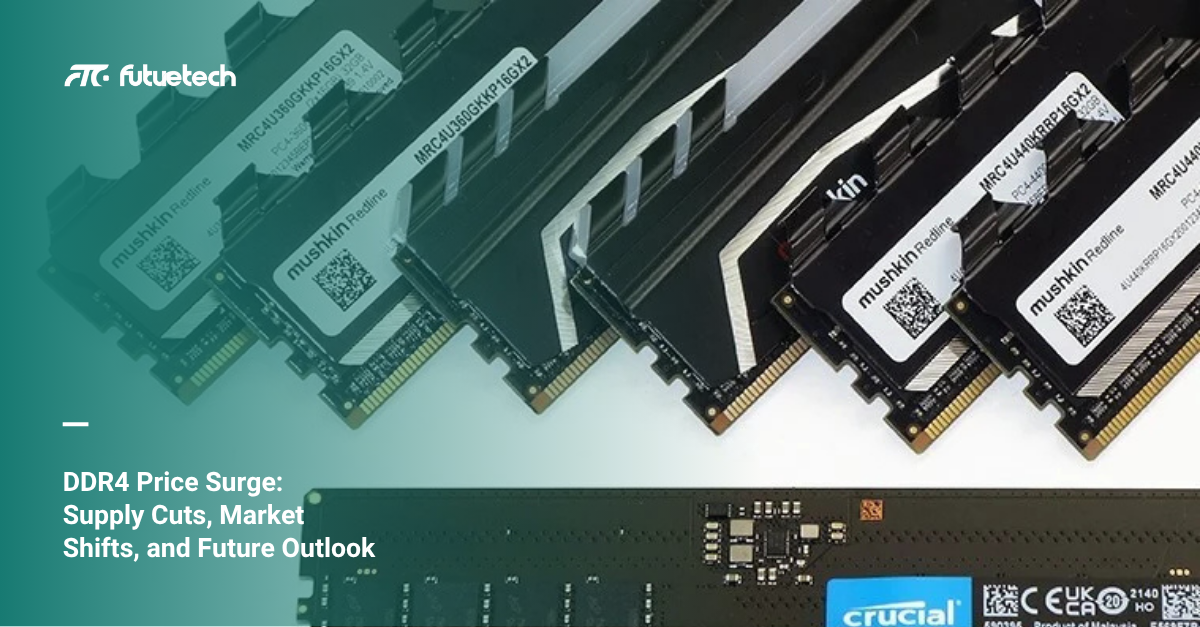In mid-2025, DDR4 DRAM is undergoing one of the most volatile price surges in recent memory. Supply cuts, strategic exits by major players, and shifting demand dynamics are reshaping this once-stable segment of the memory market.
According to TrendForce’s DRAMeXchange, DDR4 16Gb chips have nearly doubled in price compared to their DDR5 counterparts. Despite being a mature technology, DDR4 is experiencing an unexpected and significant rally, driven by a combination of supply-side constraints and strategic realignments by global memory giants.
Price Spikes and Supply Shortages
DDR4 prices have surged sharply across both contract and spot markets in Q2 2025:
● In May, DDR4 spot prices jumped 53% month-on-month — the steepest increase since 2017.
● On June 13, 8Gb and 16Gb DDR4 chips rose nearly 8% in a single day, with SK Hynix and Micron revising quotes upwards by up to 50%.
● By late June, the average spot price for DDR4 16Gb (1Gx16) 3200 hit $12, more than double the price of DDR5 16Gb chips, which remained steady at around $6.
● Local markets such as Shenzhen’s Huaqiangbei reported shortages: “Prices are up 20% in a week, and even with cash in hand, stock is unavailable,” vendors noted.
This wave of price hikes is not solely driven by demand but stems from a dramatic shift in supply strategies by the industry’s key players.
Top DRAM Vendors Exit DDR4 Production
The most critical factor behind DDR4’s price surge is the coordinated exit of the world’s top three DRAM suppliers — Samsung, SK Hynix, and Micron — from the DDR4 segment:
● In April, Samsung issued EOL (end-of-life) notices for multiple DDR4 modules, with final shipments scheduled by December 10.
● SK Hynix plans to reduce DDR4 output from 30% to 20% of its DRAM production in 2024, reallocating capacity to HBM3E and LPDDR5X for AI and server applications.
● Most recently, Micron notified customers of its planned DDR4 production exit, phasing out shipments over the next 2–3 quarters, while continuing limited supply to long-term industrial and automotive clients.
The rationale is twofold: first, to prioritize higher-margin next-gen memory (DDR5, HBM); second, to avoid further competition in an increasingly cost-sensitive DDR4 market where Chinese manufacturers are gaining traction.
Adding to the uncertainty are reports that the U.S. may revoke export waivers for Samsung and SK Hynix's Chinese fabs — a move that could further tighten supply chains and accelerate DDR4’s retirement.
What’s Next for DDR4 Prices?
TrendForce expects contract prices to rise even faster than earlier estimates:
● PC DDR4 contract prices: expected to rise 13–18% QoQ (vs. the earlier estimate of 3–8%).
● Server DDR4: forecasted to increase 18–23% QoQ.
SK Hynix and Micron are currently finalizing their last major DDR4 supply agreements, which is further driving up spot prices. With fewer suppliers, any speculative stocking or policy shocks could push prices even higher in Q3.
However, some industry observers urge caution: while production is shrinking, inventory has not yet been depleted. If panic buying slows or sentiment shifts, prices may correct, especially in the channel market. As one distributor warned: “Be wary of stockpiling — you might end up holding the bag.”
Opportunity for Chinese Memory Vendors
The global exit of major players is opening up space for Chinese DRAM manufacturers. In LPDDR4, for example, domestic players held just 15% market share in 2024, but this could grow to 25–30% in 2025 following Micron’s exit.
Recent statements from key Chinese memory firms highlight optimism:
● Longsys said the memory market has been recovering since March 2025 and the company is adjusting capacity accordingly.
● Biwin noted that supply-demand conditions are improving, and pricing is gradually stabilizing.
● Beijing Junzheng is expanding its DDR4/LPDDR4 product line using more advanced manufacturing processes.
Backed by favorable policy, ecosystem support, and rising domestic demand, Chinese vendors are well-positioned to capture market share in segments such as consumer electronics, industrial control, and networking.
Conclusion: A Turning Point for DDR4
While DDR4 is clearly approaching the end of its lifecycle, the current price rally shows that it still plays a vital role in the global memory landscape. The coordinated exit of major suppliers, combined with policy shifts and structural demand, has turned DDR4 into a supply-constrained commodity — at least in the near term.
For buyers and channel partners, the key is risk management. Secure strategic stock where needed, but avoid speculative purchases based solely on price momentum.
At the same time, the transition to DDR5 and HBM technologies will continue to accelerate. As the DRAM landscape enters a new era, agility, supplier diversification, and access to verified substitutes will become critical success factors.
Futuretech Components offers professional support for your memory sourcing strategies. Whether you seek DDR4 stock, DDR5 upgrades, or cost-effective alternatives, our global network and quality assurance help ensure resilience in a volatile supply environment.
Contact us to explore tailored solutions for your DRAM supply chain needs.



